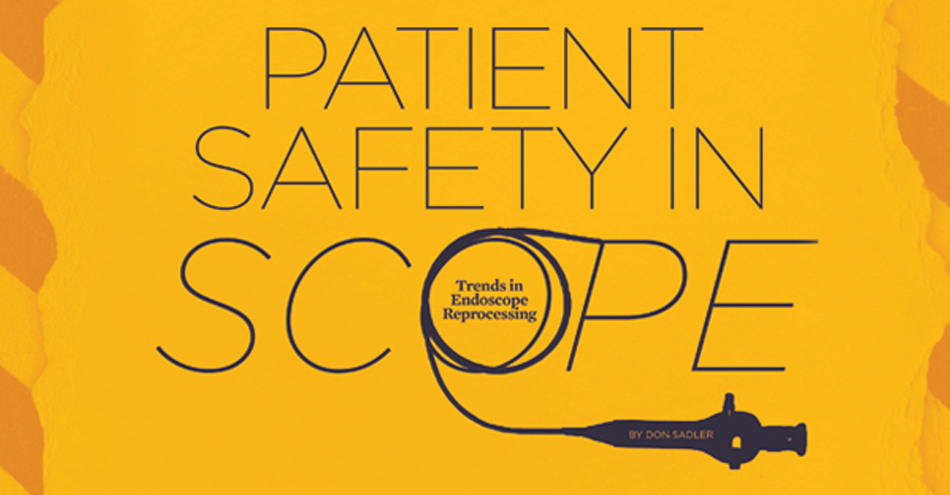Patient Safety in Scope
Trends in Endoscope Reprocessing
by Don Sadler
According to the Society of Gastroenterology Nurses and Associates (SGNA), every reported case of hospital acquired infection associated with a contaminated Gi endoscope has been linked to a breach or violation of at least one of several requisite reprocessing steps.
Gastrointestinal (GI) endoscopes are among the most sensitive and expensive pieces of equipment in the modern operating room. This makes proper handling, cleaning and storing of endoscopic devices an important consideration for perioperative nurses and surgical techs today — especially when you consider that disease outbreaks have been associated with breaches in proper cleaning and disinfection of endoscopes, according to the Centers for Disease Control.
“Endoscope handling and cleaning has become a real hot-button topic,” says Dante Tisci, the division president of Medline’s Dynacor Manufacturing Division. Sydney Nye, RN, MBA, a senior product manager with Richard Wolf Medical Instruments Corp, concurs: “It is imperative that OR personnel take the time to do a thorough cleaning and disinfection of endoscopes between uses. You simply cannot take shortcuts or hurry this process.”
POTENTIAL NEGATIVE OUTCOMES
Both Tisci and Nye stress that a wide range of negative outcomes may result from improper handling, cleaning and storing of endoscopic devices. First and foremost, of course, is patient infection: “E-coli bacteria can be passed among patients via unclean endoscopes, which can result in a very serious infection outbreak,” says Nye. Tisci adds that hepatitis B, HIV and a host of other GI-related organisms can also be transmitted from patient to patient this way.
“In addition, a facility outbreak would result in very negative media coverage for the hospital or facility, financial loss and possibly fines, lawsuits and increased regulatory scrutiny,” says Tisci. “There’s a high cost involved with scope damage — endoscopes cost about $25,000 to $30,000 apiece, and repairs average $5,000.”
Also consider the fact that facilities have a limited number of endoscopes available at their disposal. “There usually aren’t extra endoscopes sitting in the bullpen waiting to be used,” says Nye. “Removing a damaged scope from the rotation will likely impact the procedure schedule for the day and limit the facility’s ability to provide patient care.”

According to the Society of Gastroenterology Nurses and Associates (SGNA), every reported case of hospital acquired infection associated with a contaminated GI endoscope has been linked to a breach or violation of at least one of several requisite reprocessing steps. “Failure to adhere to established reprocessing guidelines or the use of defective equipment accounts for all of the reported cases of bacterial and viral transmissions.
However, endoscopes reprocessed appropriately in accordance with reprocessing and infection control guidelines pose virtually no risk of transmission of patient-borne or environmental microorganisms,” notes SGNA.
SGNA has published Standards of Infection Control in Reprocessing of Flexible Gastrointestinal Endoscopes to be used for all settings where gastrointestinal endoscopy is practiced. The standards specify that only individuals who are able to read, understand and implement instructions on the proper cleaning and highlevel disinfection of GI endoscopes and accessories should be given the responsibility to reprocess such instruments. In addition, all staff in any setting where GI endoscopy is performed must adhere to infection control principles that will maintain a safe environment, free from the possibility of spreading disease to patients and co-workers. This is true regardless of the setting — hospital, clinic, ambulatory care center or office — and applies to any and all types of GI procedures performed.
SGNA notes that flexible endoscope reprocessing has been shown to have “a narrow margin of safety.
Any slight deviation from the recommended reprocessing protocol can lead to the survival of microorganisms and an increased risk of infection.” SGNA’s reprocessing protocol outlines eight basic steps for cleaning and performing highlevel disinfection of GI endoscopes:
- Pre-cleaning
- Leak testing
- Manual cleaning
- Rinse after cleaning
- High-level disinfection (manual or automated)
- Rinse after high-level disinfection
- Drying
- Storage
Nye recommends that if you are ever in doubt about endoscope reprocessing protocols, you should go back to the manufacturer’s instructions for use. “This is what the Joint Commission is going to ask you: Are you following the manufacturer’s instructions for use for this particular endoscope?”
MANUAL VS. MACHINE REPROCESSING
According to Tisci, most flexible GI scopes today are reprocessed using an automated equipment reprocessor (AER), a machine designed for the purpose of cleaning and disinfecting endoscopes and accessories. “Chemical vapors are a concern with manual reprocessing.” However, SGNA stipulates that meticulous manual cleaning must precede the use of an AER.
“Manual reprocessing steps must be repeated the same way each and every time,” Nye adds. “An AER automates and standardizes this process, which ensures that the proper reprocessing steps are taken in the proper order every time.”
In a blog post on reprocessthis.com, Jennifer Burrell, the director of education and clinical compliance for Integrated Medical Systems International, noted that she has seen an insurgence of new endoscope reprocessors popping up at different facilities. “However, few facilities have managed to incorporate these units properly within the Sterile Processing Department. Many of the systems that I’m seeing are being placed in the decontamination area very close to where all of the other cleaning and disinfection is taking place. This is incorrect. The Joint Commission has taken the position that endoscope reprocessors should not be placed anywhere that would allow the scopes to be re-contaminated.”
One blog commenter noted that her facility was cited because its reprocessor was located in the decontamination area. Construction was undergone to rectify the situation and relocate the unit to a room located between the decontamination area and the clean area. Another commenter noted that this is often unavoidable in older facilities like where he works, but they have processes in place to avoid recontamination to the best of their abilities, like donning new gloves, a new gown and avoiding areas where decontamination is being performed as the endoscope is passed to the clean side to be tagged and transported.
The Joint Commission also states that if the reprocessor is in the decontamination area, all other decontamination processes must cease, the area must be cleaned, and all PPE must be changed prior to reprocessing the scope. “In fact, this has become a Joint Commission patient safety goal,” Nye notes.
Another issue revolves around who is responsible for handling the reprocessing of GI endoscopes — an endoscopic technician or the OR nurse or surgical technician? “This is usually determined by personnel availability and the size and type of facility,” says Tesci.
“At endo centers where endoscopy procedures are performed all day long every day, there is usually an endoscopic technician present who handles endoscope reprocessing. In multi-discipline ORs where many different kinds of procedures are performed, the nurse is often responsible for reprocessing.”
RESOURCES FOR ASSISTANCE
Nye says that Richard Wolf Medical Instruments has created an endoscope reprocessing training series to help educate perioperative nurses about cleaning and sterilization of narrow-channel flexible endoscopes. The series was debuted in March at the 60th Annual Congress of the Association of periOperative Registered Nurses (AORN) in San Diego.
The training series includes step-by-step posters that can be displayed in perioperative and central sterile supply settings, a 19-minute video on reprocessing flexible endoscopes, a technical paper authored by Nye, and a checklist to help hospitals document the competencies used to train their employees in reprocessing and sterilization. “This orientation competency checklist covers everything the staff needs to know to perform reprocessing and sterilization for flexible endoscopes,” says Nye.
In addition, Tesci says that Medline has partnered with Cygnus Medical to include its care and handling products for endoscopic instruments in Medline’s procedure packs. The products include First StepTM Bedside Kits, CaterpillarTM Brushes and OasisTM Scope Transport Trays. You can learn more about the Medline procedure packs at www.medline.com.












